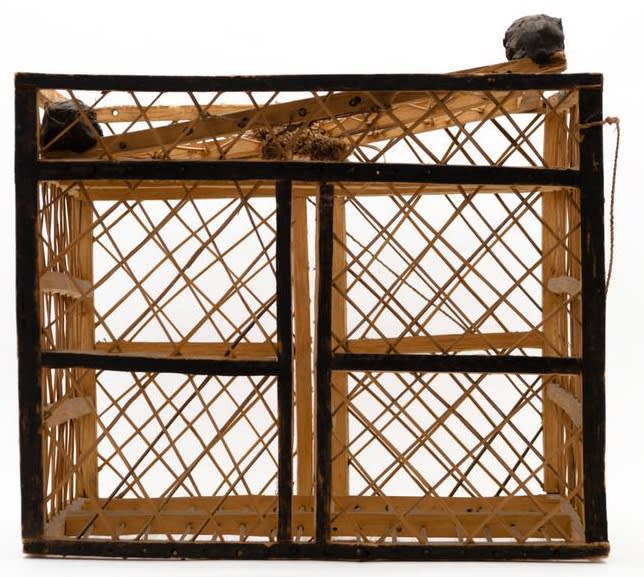
You are looking at a rare Chokwe bird trap from Angola, held in the collection of the Horniman Museum in London (info). It is made from a soft wood for the frame, and strips of cane for the bars. Such a trap was composed of two compartments: the upper, with the deadfall lid (weighted with lumps of gum) and seed bait, and the lower, divided from upper by bars and provided with perch (where the live decoy bird would be).
The Chokwe expert Marie-Louise Bastin wrote about these dead-fall traps in 1961:
The Chokwe like to hear birds sing. So they keep the kasakala canary (Serinus mozambicus), a delicious singer, as a cagebird. The little cage, called cisakala (pl. yisakala) is rectangular, of vegetable matter, consisting of a frame and a fine interlocking lattice. They hang the cage with the little Mozambique canary in the shade among the trees, near houses, and feed it with its favourite seeds; on journeys they take it with them as a cheerful companion. All this was related by explorers during the last century, starting with Livingstone in 1873. It is thus that the most widespread Chokwe decorative motif is called maswi a yisakala, “net of cages”: a drawing with symmetrically crossing parallel lines, usually forming a diamond shape or adjacent diamonds. Maswi a yisakala is also the name given to a seed-like keloid tattoo which decorates men’s and women’s skins, in the form of a fine checkered embroidery (Bastin 1961, IV.c.d.7).
Below two examples of this motif. I’m sure you can easily find others yourself and hopefully will never look the same again at such decorations. As always in African art, everything refers to something, and we can only do our best to decipher these visual clues as good as we can.


Thanks to Guy van Rijn for the tip!